2025 State of Patient Access Report
Patients with chronic health conditions still struggle to access and afford the care they need. These challenges include everything from insurance barriers to medication costs.
The State of Patient Access Report is a groundbreaking research initiative of the PAN Foundation’s Center for Patient Research which surveys patients with chronic health conditions directly about the challenges they face in healthcare access and affordability. The report uses a comprehensive national survey conducted by The Harris Poll.
In the 2025 State of Patient Access survey, patients shared that healthcare access and affordability is not improving and is getting worse in some cases. Overall, more than one in five patients reported that prescriptions are not affordable (23 percent), and they find it difficult to pay for medication costs (22 percent). A quarter of patients said their lives are greatly impacted by the financial toxicity of healthcare costs. Explore a summary of our key findings on this page—and download the 2025 State of Patient Access Report for more details.
2025 Scorecard

In our 2025 State of Patient Access survey, more than 2,700 adult patients with chronic health conditions answered questions in five key categories. All patients surveyed had been diagnosed by a healthcare professional with at least one chronic health condition. More than half (54 percent) had multiple chronic health conditions, with nearly one in ten (9 percent) having five or more conditions. Their responses were given an aggregate score in five categories.
- Overall Access to Care = C+ (78.9)
- Relationship with Healthcare Professionals = B (84.3)
- Affordability of Prescription Medications = B- (80.8)
- Access to Treatment through Healthcare Plans = D- (63.1)
- Financial Toxicity = D+ (68.8)
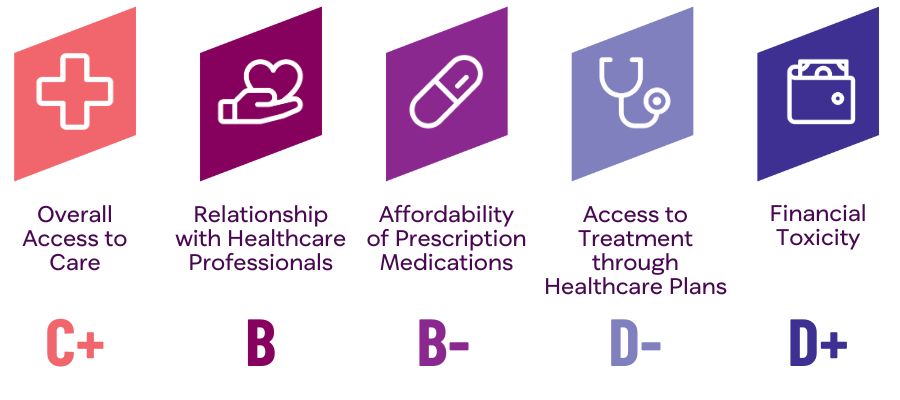
Read our complete 2025 State of Patient Access Report, including an analysis of the survey responses from each scorecard category.
Key findings
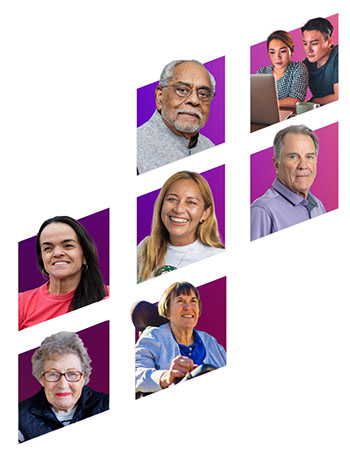
Healthcare access and affordability is not getting better, and in some cases, it is getting worse.
When compared to the scorecard ratings from the 2024 report, this year’s survey indicates that not much has changed in terms of patient access. In fact, most categories did not change much from 2024 to 2025. This reflects persistent challenges with healthcare access and affordability.
In comparison to last year’s survey, Overall Access to Care, Relationship with Healthcare Professionals, and Access to Treatment through Health Plans nudged up slightly or remained essentially flat. Yet, Affordability of Prescription Medications and Financial Toxicity declined.
Having health insurance does not guarantee access to timely, affordable healthcare.
The ability to Access Treatment through Health Plans earned a “D-” across all patients. It once again came in with the lowest overall grade across the five categories. Almost half (48 percent) of insured patients who take prescription medications reported facing some form of insurance-related barrier to accessing their prescriptions. More than three out of 10 (35 percent) respondents who have a deductible as part of their healthcare plan said that deductible had been unaffordable in the past year.
Notably, the score for this category fell to a failing grade of an “F” among American Indian/Alaska Native, Hispanic, and LGBTQIA+ patients. This highlights the continued differences in health outcomes based on a person’s identity and the impact a patient’s identity can have on their ability to access care through their health plans.

Affordability of prescription medications continues to drop, with negative outcomes for patients.
Although Affordability of Prescription Medications earned a “B-” again this year, the score dropped significantly from 82.3 in 2024 to 80.8 in 2025.
Lack of affordability hits the following groups the hardest:
| Surveyed group: | Grade | Score |
| Uninsured people | D+ | 67.2 |
| Generation: Gen Z | C | 73.2 |
| People with rare diseases | C | 73.8 |
| Generation: Millennials | C | 74.0 |
| Hispanic | C | 74.0 |
| American Indian/Alaska Native | C | 74.6 |
| People in the LGBTQIA+ community | C | 75.0 |
| Pacific Islander/Native Hawaiian | C | 75.2 |
| Black/African American | C | 75.8 |
| People living in urban areas | C+ | 77.6 |
| People living in the South | C+ | 79.2 |
Overall, more than one in five (22 percent) patients who take at least one prescription medication said it was difficult to pay for prescriptions in the past year, and 23 percent of patients who had medication costs said that prescriptions were not affordable. One in five (21 percent) patients said they could not get the prescription they needed because of cost, putting their health at risk.

Financial toxicity continues to represent a serious issue for many.
Patients rated Financial Toxicity as a “D+,” dropping from a “C-” in 2024. Financial toxicity is the impact on mental and physical health associated with affording treatment for your chronic condition. A quarter of patients (25 percent) said financial toxicity affects them a great deal, an increase compared with 2024 results (23 percent).
More than half (56 percent) of LGBTQIA+ patients surveyed said they experienced a great deal of financial toxicity due to the cost of healthcare. This is nearly double as reported by non-LGBTQIA+ respondents (24 percent). Hispanic patients rated Financial Toxicity an “F,” and Black patients’ rating dropped from a “D” in 2024 to a “D-” in 2025.
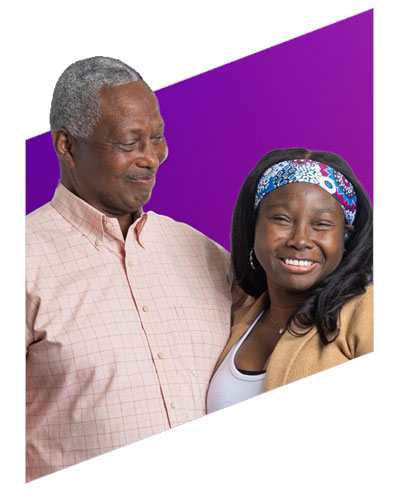
Across all measures, people experienced negative impacts based on personal identity characteristics.
Nearly two in five (38 percent) patients reported feeling that some aspect of their identity negatively impacts their ability to get the best possible healthcare. Income, insurance status, and age were most frequently mentioned, but people also noted location, job status, race, disability, education level, gender identity, sexual orientation, and religion. Throughout our research, we found differences among groups in nearly every category.
Medical debt is a leading concern among patients, impacting their overall wellbeing.
This year’s research also explored three new areas not included in the scorecard: Negative Impacts of Medical Debt, Patient Knowledge about Healthcare Plans, and Use of Technology in Healthcare.

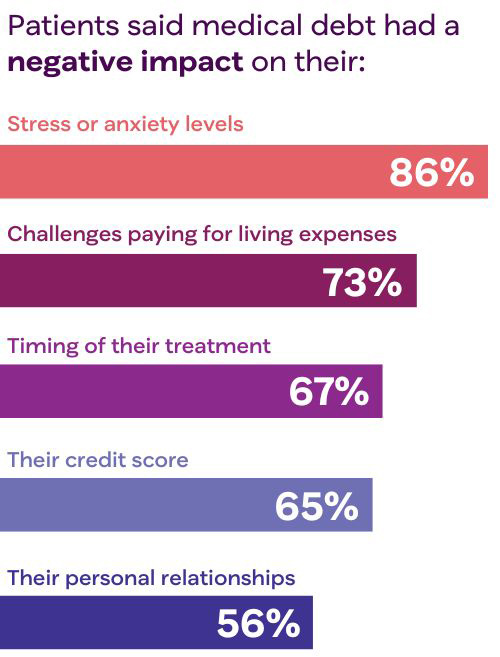
Two in five (40 percent) respondents reported having some amount of medical debt, averaging $729. Patients of color averaged $983 in current medical debt, compared to $584 among white patients.
Patients said that their medical debt had some degree of negative impact in these ways:
- Patient’s stress or anxiety levels (86 percent)
- Challenges paying for living expenses (73 percent)
- Timing of their treatment (67 percent)
- Their credit score (65 percent)
- Their personal relationships (56 percent)
Population insights
Explore the population-specific insights from our 2025 survey. Download our focus briefs on the following patient groups:
- Females
- Gender identity and sexual orientation
- Geographical region and urbanicity
- Health condition
- Health insurance status and type
- Racial and ethnic subgroups
Our 2025 State of Patient Access Report suggests that healthcare access in the U.S. continues to be a challenge for far too many, pointing to a growing crisis that is likely to persist without concerted actions. Our findings reinforce the need for tangible, long-term policy solutions that help to accelerate and improve access to care.”
Amy Niles, Chief Mission Officer, PAN Foundation
Watch our webinar about the report
Methodology
Survey methodology
The research was conducted online in the United States by The Harris Poll on behalf of the PAN Foundation among 2,723 adults age 18+ who reside in the U.S. and have by diagnosed by a healthcare professional with a chronic health condition (including 2,578 completes from the general population and race/ethnicity oversamples and 145 completes from the LGBTQIA+ oversample). The survey was conducted in English and Spanish between August 1 and September 2, 2024.
Respondents for this survey were selected from among those who have agreed to participate in our surveys. The sampling precision of Harris online polls is measured by using a Bayesian credible interval. For this study, the sample data is accurate to within + the below percentage points using a 95 percent confidence level:
- Total: +/- 2.8 percentage points
- Hispanic: +/- 6.8 percentage points
- Black/African American: +/- 5.8 percentage points
- Asian: +/- 7.0 percentage points
- Native Hawaiian/Other Pacific Islander: +/- 13.6
- American Indian/Alaskan Native: +/- 13.3 percentage points
- LGBTQIA+: +/- 7.1 percentage points
This credible interval will be wider among subsets of the surveyed population of interest.
All sample surveys and polls, whether or not they use probability sampling, are subject to other multiple sources of error which are most often not possible to quantify or estimate, including, but not limited to coverage error, error associated with nonresponse, error associated with question wording and response options, and post-survey weighting and adjustments.
Scorecard methodology
To assess the state of patient access in the United States, The Harris Poll, on behalf of the PAN Foundation, synthesized the patient survey results into a 2025 State of Patient Access Scorecard organized across five key categories. To arrive at an aggregate score for each domain, they used composite indices, which incorporate a variety of survey questions and response options, each assigned a weight.
The weights assigned to each question or response option total 100 within each index category. Individual respondents were then assigned a score between zero and 100, based on their responses to the survey questions included in the indices.
The average of all respondents’ scores resulted in a composite index score, which summarizes a subset of attributes or dimensions into a single metric. Each metric synthesizes patients’ views and experiences in a particular domain. The scores were calculated both at the total patient level, and for a variety of subgroups within the broader patient population to highlight any disparities in access to care.
For a detailed analysis of response data and more information about our survey methodology, download the 2025 State of Patient Access Report.
Next steps
We hope these findings help inform efforts by patient advocacy organizations, policymakers, and industry leaders to improve healthcare access and affordability for all. Here are some specific actions you can take today:
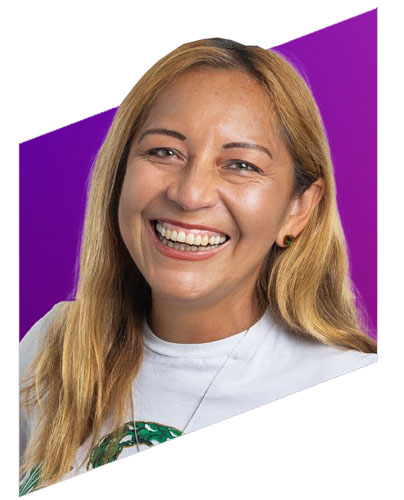
Patients
- Advocate for yourself by asking your healthcare provider and health insurance plan questions related to your care and coverage.
- Educate yourself about how to better navigate your healthcare journey and available resources, such as charitable patient assistance foundations.
- Seek out resources from disease-specific and patient advocacy organizations.
- Participate in advocacy with the PAN Foundation as we work to improve healthcare access and affordability for all.
- Share your story with policymakers and others through organizations like the PAN Foundation.
Healthcare professionals
- Have conversations with your patients about their healthcare access and affordability challenges.
- Identify resources, like the PAN Foundation, that you can share with your patients.
- Empower your office staff and team members to connect patients with resources to help them navigate their healthcare journey.
- Become an advocate with the PAN Foundation as we encourage policymakers to put patients first.
- Share your story about how healthcare access and affordability challenges are impacting your patients.
Patient advocacy organizations
- Ensure your policy priorities are addressing the access and affordability challenges outlined in the 2025 State of Patient Access Report.
- Partner with like-minded organizations to strengthen your collective voice around key healthcare access and affordability issues.
- Educate patients and healthcare professionals about key issues impacting patient access.
- Leverage your own Hill Day or other advocacy events to advocate for patient-centered policy solutions.
- Use data from the 2025 State of Patient Access Report in your materials and resources to further emphasize the access challenges facing patients.
About the State of Patient Access Report
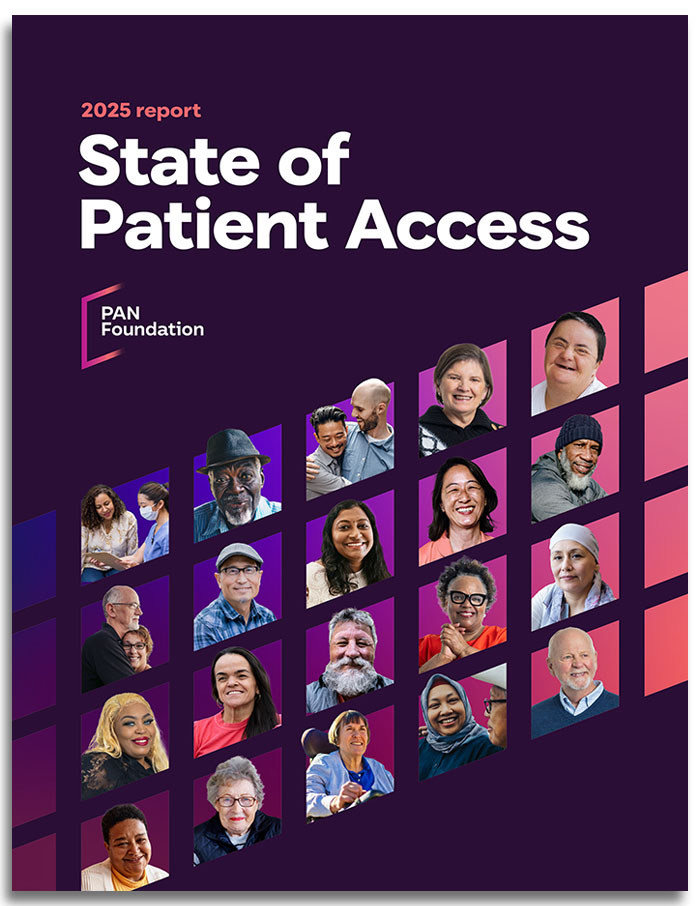
The State of Patient Access Report is a flagship research initiative of the PAN Foundation’s Center for Patient Research, exploring the challenges faced by patients when it comes to healthcare access, and their impact on different communities. Launched in 2024, this groundbreaking initiative uses a comprehensive national survey, conducted by The Harris Poll, to hear directly from adults with chronic health conditions.
DOWNLOAD our reports:
About the PAN Foundation’s Center for Patient Research
The PAN Foundation’s Center for Patient Research provides evidence-based insights that convey the diverse needs of patients as they navigate the healthcare system and challenges accessing affordable, equitable care. Through rigorous methodologies, the Center for Patient Research aims to understand the challenges faced by patients, translate these findings into actionable knowledge for healthcare stakeholders and policymakers, and help inform policies that lead to accessible and affordable healthcare for all.
-
Subscribe to news
Sign up to receive PAN news, from helpful articles to action alerts.
Subscribe today -
-
